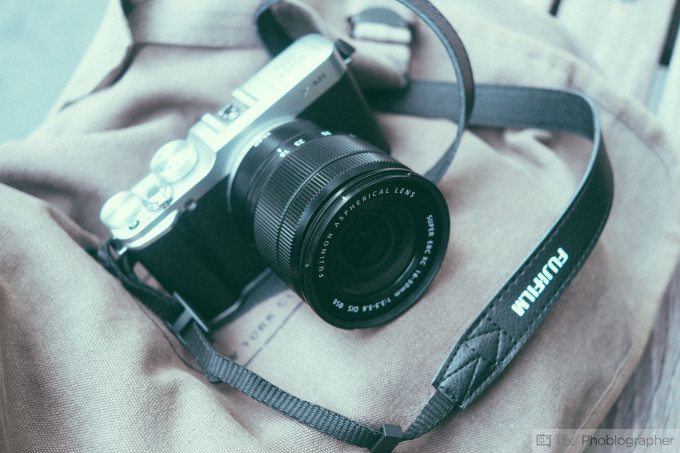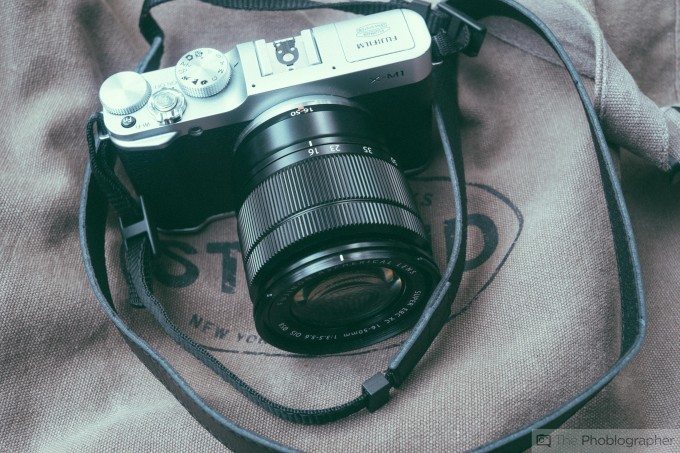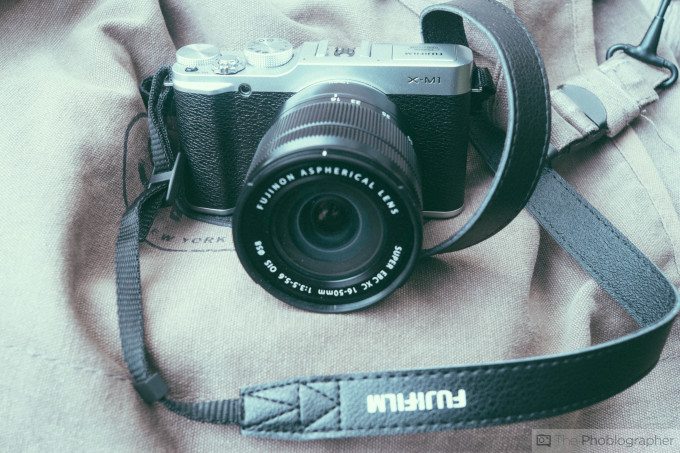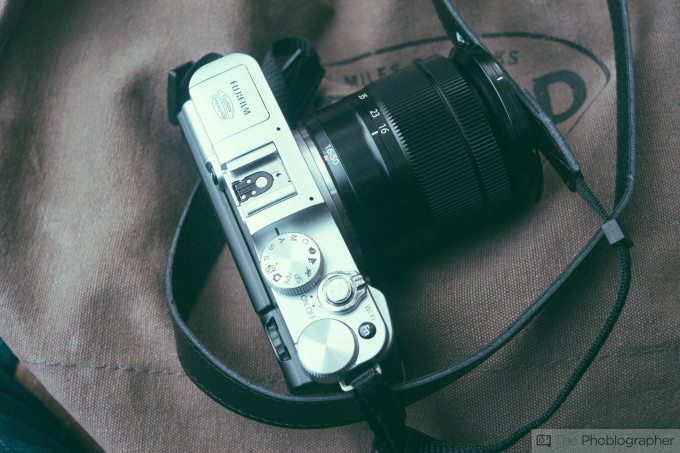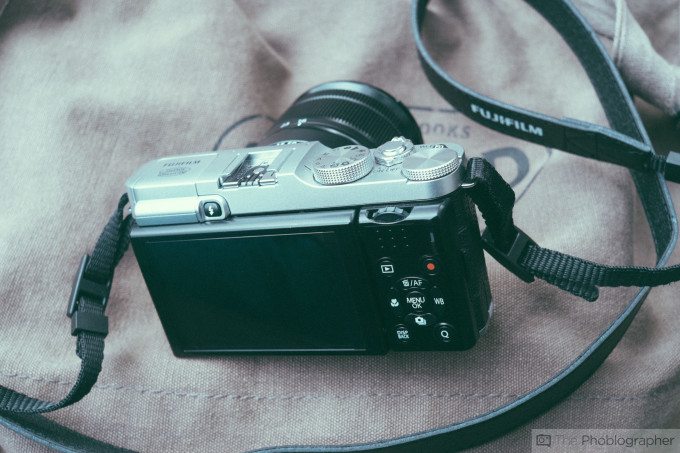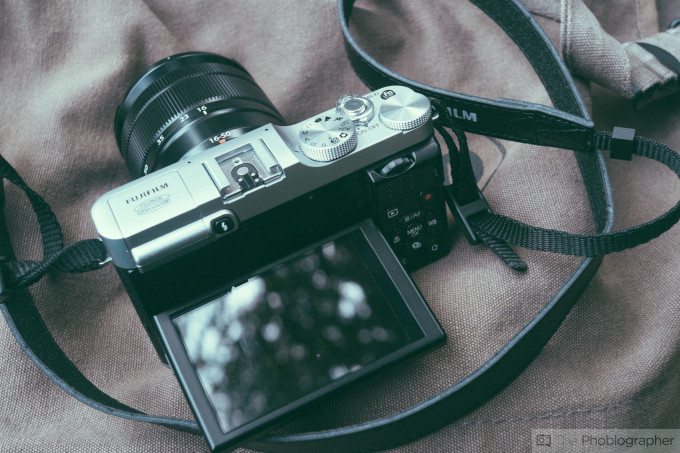It seems to be a winning formula for many camera manufacturers: take the specs and sensor of your higher end cameras and put it in a dumbed down body–then market it to the entry level crowd. Lots of camera manufacturers do it, and the XM1 really feels like it. If you’re partial to Fujifilm’s higher end X series camera bodies and then get a hold of their XM1, you’ll immediately know that the XM1 wasn’t designed for you. For starters, they got rid of the viewfinder. Instead, they added in a tilting LCD screen and even added two dials that might appeal more to the entry level crowd that has never felt what aperture control being around a lens might be like.
And then there is that 16-50mm f3.5-5.6 kit lens. It bears all the attempts at Fujifilm trying to go for the crowd that are new to interchangeable lens cameras.
Pros and Cons
Pros
– Exceptional image quality; the best of any entry level camera that we’ve tested
– Compact size
– The tilting LCD screen can be fun to use
– WiFi Connectivity
Cons
– Autofocus wasn’t significantly faster than that of the X Pro 1’s
– We feel that someone would want an external EVF to use
– It would have made a lot more sense if the screen was touch functional
Gear Used
For this review, we tested the Fujifilm XM1 with the 16-50mm f3.5-5.6, 27mm f2.8, and the 35mm f1.4 R.
Tech Specs
Specs taken from the B&H Photo listing
- 16.3MP APS-C X-Trans CMOS Sensor
- Fujifilm Proprietary X-Mount
- Includes 16-50mm XC Lens
- 3.0″ 920k-dot LCD Tilt Monitor
- Built-in Wi-Fi Connectivity
- Full HD 1080p Video with Stereo Sound
- Focal Plane Shutter
- 100-25600 ISO Sensitivities
- Magnesium Alloy Body
Ergonomics
Fujifilm’s XM1 is a camera that isn’t as appealing in the looks department as its bigger brothers, but that doesn’t mean that it can’t have a heart of gold. When it comes to its exterior, you’ll probably notice that it likens itself very much to similar offerings from Samsung and Olympus.
With that said, the front of the camera is very plain Jane and has no functionality or controls on the front with the exception of a lens release.
The top of the XM1 doesn’t adhere as much to the retro-inspired lineage design as the X Pro 1 or the XE1. So what you get instead is a pop-up flash, hot shoe, mode dial, shutter release, on/off switch, function button, and two dials. One dial is on top while the other is tucked away neatly behind it.
On the back of the camera is where you’ll find lots of other controls. Fujifilm decided to keep them huddled to the right hand side of the camera body. As a result, the video record, playback, four way settings, and more are all clumped together. Sometimes it was be a bit confusing, but we became used to it after a while.
The controls are next to a giant LCD screen that is situated right below the pop-up flash button.
What’s unique about that big LCD screen though is that it tilts up and down. This works great when shooting from the hip.
Build Quality
The XM1 is characterized by a magnesium alloy body–which is the same metal used in many higher end DSLRs. We’d be doing this camera a massive injustice if we said it wasn’t the best damn built and most durable entry level camera out there. Indeed, not a single thing feels cheap about it.
Ease of Use
We spent some time with the camera set to auto or Program mode while shooting. It was as simple as pointing and clicking–which most users will surely love. When it came to manual manipulation of settings, using the two dials positioned in pretty much the exact same spots was a bit difficult to wrap our head around. But as it is, we appreciate that Fujifilm kept two dials in there. However, we wish that the company put one on the front and kept the one on top.
When it came to Wifi usage, there was a slight hiccup the first time we tried to set up wifi sharing on our Android device. But after that, it was totally smooth sailing.
Seriously–Instagram never looked this good.
Keep in mind though that if you’re a more advanced user, we recommend shooting in RAW and converting that image to a JPEG in the camera. After this, you should send the JPEG to the app. Yes, the app can only see JPEGs–and isn’t as advanced as Samsung’s or Sony’s experiences.
Autofocus
We found the XM1 to be slightly faster than the X Pro 1, but nowhere as fast as the speed demon that the X100s is. In good lighting, it is fastest to focus with the 16-50mm kit lens. When it comes to lower lit situations though, it can sometimes hunt but is usually fairly quick except in the deepest, darkest parts of a bar.
As it is, Fujifilm’s autofocus system isn’t class leading. Olympus and Sony still have a significant focusing speed advantage over the company’s current line of interchangeable lens cameras as of this publication.
Metering
In a Sunny 16 test, the Fujifilm XM1 consistently underexposed by 1/3rd of a stop. To double check, we ran the test again the results from a handheld light meter and they added up.
If you’re in Program, Aperture or Shutter priority, we recommend that you boost the exposure compensation just a tad.
Image Quality
What happens when you take the best APS-C sensor in the business that just so happened to be in your flagship camera and put it in your entry level camera? Well, you get some damned good image quality that can rival that of a full frame camera’s performance.
Now let’s think about that statement: Fujifilm gave an entry level camera the image quality performance to outdo some full frame cameras. The reason for this is their exceptional X Trans sensor that renders spectacular colors and detail and also manages to keep high ISO image noise down. But on top of this, the camera’s RAW files are also very versatile and with the right program they can really do almost anything as long as you have the basics concepts of metering down and studied.
But this camera isn’t necessarily for those folks–and many users tend to leave their cameras in auto and just shoot. As much as we want to grab them, smack them for not embracing the fullest potential, and then smack them again until a proper black eye and fat lip have been delivered, we have to say: the JPEG quality of this camera is also very good. If you’re more inclined to shoot JPEG images, then you should be aware of Fujifilm’s color renderings that try to mimic the look of their older films such as Astia and Velvia. But the XM1 doesn’t have all the film renderings that the X Pro 1 does. While this means almost nothing for a RAW shooter, it could mean everything to a JPEG shooter as it means getting everything perfectly correct in the camera the first time around.
The camera’s JPEG conversion engine is also worthy of talking about–especially when converting an image to a black and white. pixel for pixel at higher ISOs, the engine crushes absolutely any noise issues and delivers a superbly sharp image with film grain that looks completely organic.
High ISO Performance
As we stated above, the high iso performance of the XM1 is excellent as it is the same sensor that is in the X Pro 1. The grain that is in any of the images is very tightly knit and looks very film-like. However, we have to admit that the high iso images of a full frame camera will look more film-like.
When we talk about noise in the images, all that we really see in luminescence noise–no other color noise to speak of only means that you’ll see better colors in your images.
On top of all this, you’ll only really see any major noise if you’re looking at your images at 100%. If you’re capturing a moment, no one cares about a 100% crop at all.
RAW File Versatility
The sensor at the heart of the XM1 is capable of recovering lots of details in both the highlights and shadows. Image for image, right out of the camera Fujifilm captures more details in the highlights anyway vs someone like Sony capturing more detail in the shadows. For what it’s worth though, you should never have any major problems with the RAW files in Adobe Lightroom.
Video Quality
Honestly, forget about it. Fujifilm doesn’t allow any sort of manual control for video in their cameras. A user can set the ISO and/or the aperture or shutter speed, but not everything at once. If you’re fine with this, then by all means go ahead. But we’d recommend that Fujifilm try to fix this with a firmware update.
However, what we believe that even more users are clamouring for is a functional time lapse mode.
Extra Image Samples
Conclusions
Fujifilm totally didn’t try to push the innovation lines with the XM1–and it isn’t meant to either. However, they included a lot of more consumer-ish features that will appeal to both the high end and entry level crowd. Not only that, but they took their award winning sensor, put it in a super rugged body, tweaked the autofocus a bit, and showed that they’re willing to change their ideas to appeal to another crowd of customers.
And for what it’s worth, we really can’t say very much bad about the XM1. A consumer might totally want a touch screen interface though and that might even make the focusing workflow even faster.
But at the end of the day, there isn’t a single major reason why you shouldn’t go with the XM1 unless you want a viewfinder.
The XM1 is available for purchase at Amazon.
Please Support The Phoblographer
We love to bring you guys the latest and greatest news and gear related stuff. However, we can’t keep doing that unless we have your continued support. If you would like to purchase any of the items mentioned, please do so by clicking our links first and then purchasing the items as we then get a small portion of the sale to help run the website.


